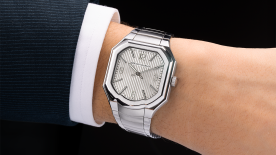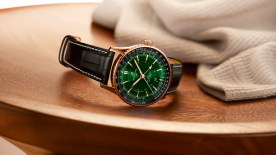26th October 2009
Benjamin Clymer - www.hodinkee.com
Chronicle
In the world of watch collecting there are two definitive categories: the vintage watches, typically described as those older than 20 years, and the modern watches, those that are within the first decade of their life.
Sitting between vintage and modern exists a small group of collectible “neo-vintage” watches that hover around the 15-20 year mark. It is around this age that collectors first start to identify the pieces that will one day become classics. It was in the late 1980s, just short of twenty years after its release, that a Rolex Cosmograph with peculiar registers started to gain momentum as a collectable. Now the Paul Newman Daytona sits atop the world of valuable and collectable sport watches.
The values of Newman Daytonas today range from $30,000 all the way up to $100,000 depending on reference number, condition, and color scheme. We tend to think that we know all there is to know about this particular piece, and so values are easily obtained.
What about today's neo-vintage collectibles though? The ones that are just now coming into the spotlight as the rare birds and grail watches of future generations. Just what are they, why are they poised to climb, and why do we know so little about them?

Let's take one of the few neo-vintage that has already raised a few eyebrows, although it remains relatively under the radar except with a few die-hard collectors; the Rolex Explorer I “Blackout”. Since the Explorer's inception over 50 years ago, the vast majority have been made with a black face and white markers, whether applied or painted on the dial itself. For what some experts claim is as little as 6 months, Rolex introduced an instance of the Explorer where the infamous 3, 6, and 9 were actually filled with black instead of white.
Originally thought to exist only in E serial numbers and with silver print on the dial, we now know that the production also included later X serial Explorers with white print on the dial. The Blackout Rolexes are rare, certainly, in fact some call it the rarest sapphire crystal Rolex to date. What is not so certain is the value of this neo-vintage oddity.
One year ago, in October of 2008, Antiquorum recorded a sale of a Rolex Reference 14270 Blackout at $12,000 US. Five months later, in Antiquorum's March 2009 auction, one sold for just over $5000, and after another five months, one sold again at just above $5000 via Antiquorum. Economic conditions aside, that is a dramatic decrease in value of a rare watch in one year's time. But did the value really decrease?

While impossible to dispute that these watches did sell for less than half of the price of less than a year ago, many sellers continue to believe the Blackout is worth close to, if not well into five figures. Running a quick scan of dealers around the world, the price range of these Rolex Blackouts is astonishing. From as low as $4500 from private sellers (watch alone) to as high as $16,000 from well known European dealers (NOS, Box & Papers), we were able to track down five Blackout Explorers, in excellent or mint condition, with boxes and papers, with an average price of $10,800. Over $10,000 for a Rolex Explorer I from the 1990s, we must be crazy. Or are we?
Charles Tearle, a Director at Antiquorum USA says “In recent years we have seen transitional variations that exist in relatively modern wristwatches, such as the Rolex Explorer I “Blackout”, matte dial submariners, and the transitional IWC big pilots, have speculative presence on the secondary market.” But does this mean that these models are worth up to three to four times what a traditional model sells for? Things are still unclear; Tearle adds “relatively little is known about quantities produced, but as we learn more, I believe the market value of these transitional pieces will become more definitive.”
While the debate over the value of these rare Rolex “Blackouts” will likely continue on, this raises a much larger issue. How are we to assess the value neo-vintage watches if experts can't seem to agree and with such a dramatic variance in auction prices? Or, maybe this isn't an issue at all, but rather one of the reasons that watch collecting continues to gain momentum as a global passion. The question now becomes, we know the Rolex Blackout Explorer is something special, but what else is out there and when will we realize it?





